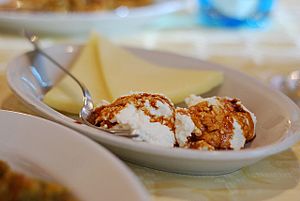Vincotto facts for kids
Vincotto (which means "cooked wine") is a dark, sweet, and thick paste. It comes from rural areas of Italy. People make it by slowly cooking non-fermented grape juice for many hours. This process reduces the juice to about one-fifth of its original amount. The natural sugars in the juice also caramelize, making it sweet and rich.
Vincotto can be made from different types of local red grapes. Some common types include Primitivo, Negroamaro, and Malvasia Nera. Before picking, the grapes are left on the vine for about 30 days to dry out a bit. In ancient Roman times, this paste was called sapa in Latin and epsima in Greek. These names are still used today in Italy and Cyprus.
You can find Vincotto made in several regions of Italy. These include Emilia-Romagna, Veneto, Lombardy, Apulia, Basilicata, Sardinia, and Marche.
Contents
What is Vincotto?
Vincotto has a very sweet flavor. It is important to know that it is not a type of vinegar. However, a sweet vinegar can be made using Vincotto as a base. This special product is often called "Vinegar of Vincotto" or "Vincotto balsamic." You can use it in the same way you would use a good, mild balsamic vinegar.
A Taste of History
Vincotto is similar to products made in Ancient Rome. These were called defrutum or sapa. Romans made them by boiling down grape juice to different thicknesses. Defrutum was used to preserve, sweeten, or flavor many foods. This included wine! People mixed it with honey or a fish sauce called garum. Romans also drank defrutum when mixed with water. They could even ferment it into a strong Roman "wine."
How Vincotto Developed
Over many centuries, Vincotto became even better in Basilicata and the Salento area of Apulia. It developed into several high-quality types. Today, it is made by slowly cooking a mix of grape juice and wine that has started to sour. This creates a thick, non-alcoholic syrup. This tradition goes back to ancient Roman times. Back then, grape juices were cooked down to make them last longer and easier to transport.
Vincotto in the Kitchen
In Basilicata, Vincotto is a key ingredient in many traditional dishes. For example, it's used in lagana chiapputa, which is pasta with walnuts, almonds, pine nuts, and raisins. It's also in pan minisc', a dessert with flour, sugar, and spices.
More recently, starting around 1863, the Salento region grew many more vineyards. This led to a big increase in Vincotto production. Vincotto can be used as a sweet topping. You can drizzle it sparingly over strong-flavored foods. It tastes great with game meats, roasted meats, poultry, aged cheeses, and risotto.
The red grapes from Apulia make wines with many polyphenols. These are like antioxidants, which are good for your health. They also make flavors stronger when added to recipes.
Other Names for Vincotto
Vincotto without added vinegar is the same as vino cotto. It is called vino cotto in southern Italian regions like Calabria. These names cannot be registered as a trademark by any company.
In Greek, Vincotto is called petimezi. It is only made in Crete. In Croatia, this product is called varenik. It is made on the Dalmatian islands and in the Dubrovnik and Skradin regions. In South Africa, it is known as moskonfyt. This Afrikaans word means "grape must jam." It is made in the Western Cape province.
Sweet and Sour Vincotto Vinegar
Like a thick, sweet balsamic "vinegar," the balsamic Vincotto Agrodolce version is very versatile. You can use it to dress salads and season cooked vegetables. It can even be used in desserts like fruits or ice cream.
These vinegars are made by mixing a sweet, aged Vincotto with vinegar. This vinegar is also made from the same red grape varieties. The mixed product then ages for several more months. It becomes "legato," which means "smooth." The result is an Apulian balsamic vinegar. You can use it like a balsamic vinegar from Modena.
Apulian red grapes and wines have many polyphenols. These act as antioxidants and natural flavor enhancers with other foods. They can make other flavors stronger in a recipe without overpowering them. Also, unlike some other balsamic vinegars, they can be cooked over heat without becoming bitter.
Vincotto with Flavors
Some Vincotto products are made with added flavors. This is similar to how flavored extra virgin olive oils are made. Local fruits are used to create these flavors. Examples include fig, carob, quince, lemon, orange, raspberry, or chili pepper. These are special versions of traditional Apulian Vincotto.
See also
 In Spanish: Vincotto para niños
In Spanish: Vincotto para niños


